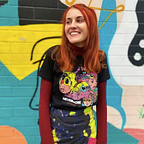Meet The Guy Who’s Mentoring Chicago’s Young Artists Through Spoken Word
He’s Chance the Rapper’s “artistic father.”
In Kevin Coval’s vibrant short film, an “Ode to Footwork,” Chicago dancer Litebulb jukes in the middle of a corner store over Chance the Rapper’s sunny “Everything’s Good (Good Ass Outro).” Coval details his mesmerizing footwork through rich, spoken word—“Tip toe kung fu kick/ Then drag the foot in molasses.”
It’s the spirit of Chicago condensed into a two-minute film. While it’s a snapshot of Chicago’s thriving contemporary arts scene, it’s also a celebration of the city’s pride throughout time—because in order to tell stories in the present, it’s crucial to look at the past.
That’s exactly what Coval does in his expansive collection of poems, “A People’s History of Chicago.” Spanning 525 years, Coval details everything from the indigenous tribe who first inhabited the city to the Cubs winning the World Series and everything in between. The poems weave together a rich narrative of all the people and events that created the groundwork for modern artists to flourish.
“I wanted to reach back in order to gain some strength in our city’s working class victories — their hard fought victories, which have come at the cost of people’s labor and sometimes their lives,” he says. “Part of what we don’t do enough of in Chicago is champion our own. [This film] is for the working people of Chicago and people of color to know that this is a city the underdog created and carved out by blood and bone.”
Upon entering Chicago’s spoken word scene in the mid ’90s, Coval became fascinated with the works of prominent writers such as Malcom X and Gwendolyn Brooks. Their words not only vividly painted moments in time, but also captured the triumphs and laments of ordinary people. In writing “People’s History,” Coval essentially wanted to “update history” so to make it engaging to young people. He credits his Jewish roots for his innate storytelling nature and desire to look at history in order to make sense of the present.
“Of course, the way that I really learned to [tell stories] was through hip hop and by taking cues from producers. They sample old records but make them relatable to the moment.” Coval explains. “I think history operates in a similar capacity.”
For Coval, the art and the city are connected. His goal is to expose a new generation of people to ideas that have been present in the community for centuries. The city’s hyper-segregation, for instance, is nothing new. It’s the way we re-tell the story, either through street art, or a poem or song, that it becomes relevant to a new group of people.
When Chance the Rapper was about to enter his freshman year of high school, he was unaware of how the upcoming years would impact him. He met Coval at orientation, and he now calls him his “artistic father.”
Chance writes in the forward of Coval’s book:
Kevin made art a job to me. He made me feel like it was real. He made me feel like the competition was real. He made me feel that the money was real. He made me feel that the love and the fans were real … He took me out of that space and made me understand what it is to be a poet, what it is to be an artist, and what it is to serve the people.
Coval’s poetry festival “Louder Than a Bomb” gives the city’s youth a platform for their art by putting young creatives in the same room. It’s a safe space where young people of all races, religions and ethnicities can commune and be themselves.
“Young people have changed Chicago because they use their own creative desire to create a culture that is counter to the hyper-segregated spaces that city planners hope remain in place,” he says.
Through music and art, young artists are fighting the city’s stereotypes, proving that Chicago is so much more than its public reputation for gun violence, gangs and a corrupt public school system makes it seem. Youths dedicated to interracial solidarity are challenging the elite by using art to demand change. They’re no longer looking at a person based on the color of their skin, their religion or what zip code they live in. They’re cheering for one another without judgement, and working to create a new, powerful movement.
Coval believes that by shifting Chicago’s culture, young people will eventually be able to influence the city’s politics. To Coval, each generation reveals new freedoms. By re-writing history that’s relevant to the city’s youth, he is hopeful young Chicagoans will channel their power into art to keep these stories alive—and thus, push the city’s culture and society forward.
Coval’s book “A People’s History of Chicago” will be released on April 11. You can preorder it here.
